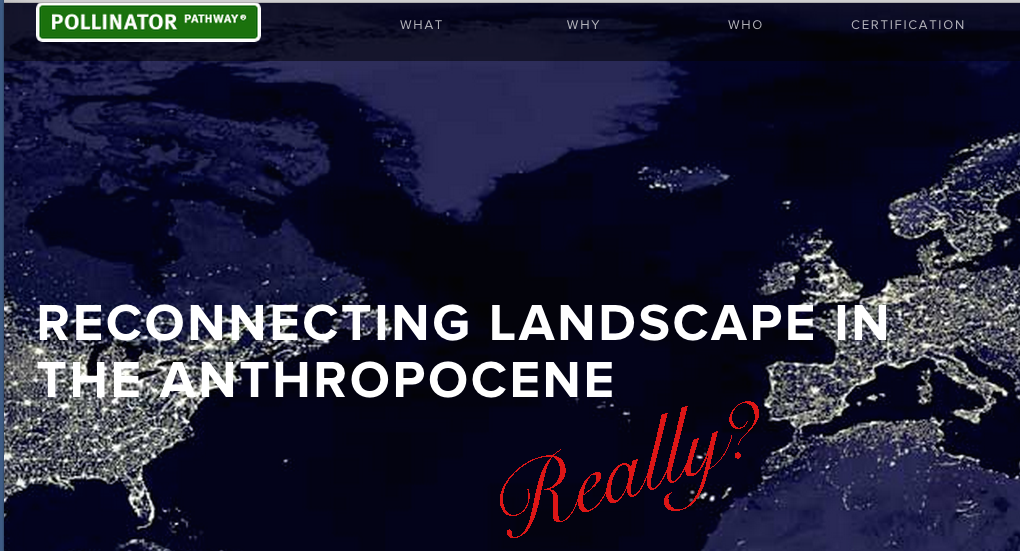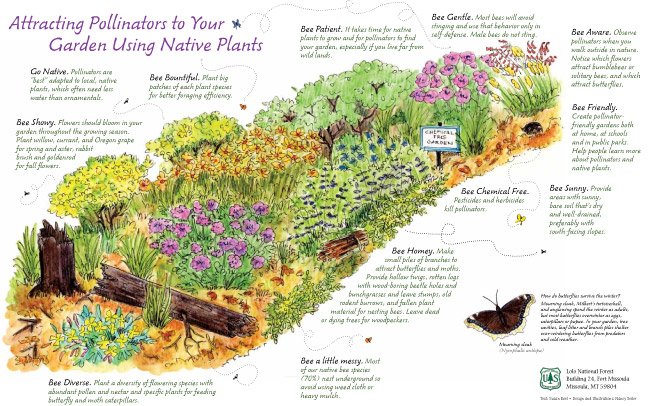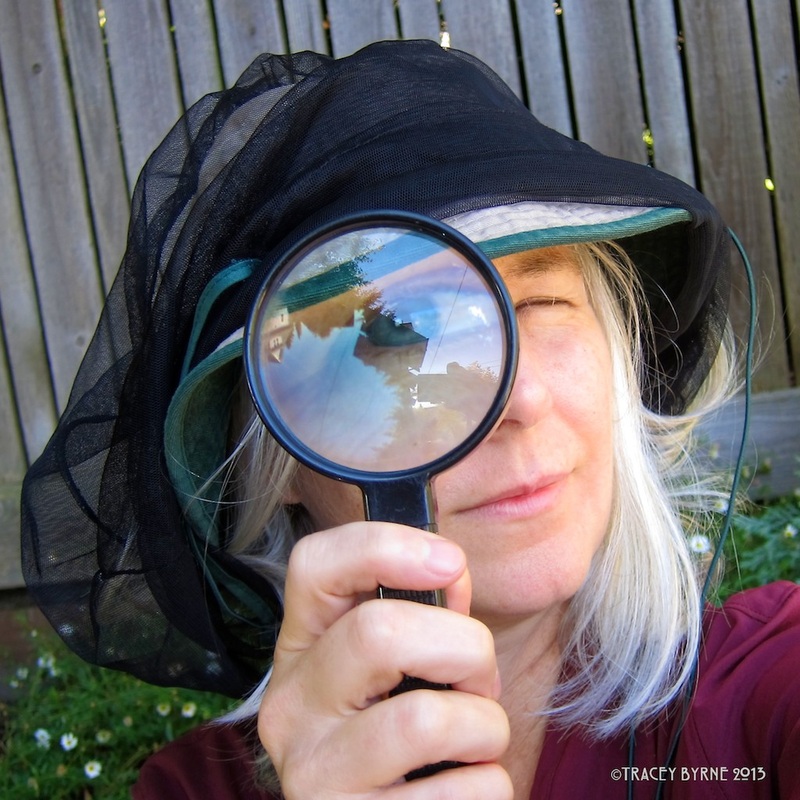In 2008, Bergmann received her first grant from the city of Seattle: $6,000 to make signs and design one garden in a 12-foot-wide parking strip of her Central District neighborhood. Her idea included a plan for a mile-long pollinator corridor. After seven years, and thousands of dollars of public funding, donations, and volunteer hours, it is hard not to wonder-where did all that money go?
Back in 2010, after Bergmann had received her second Department of Neighborhoods grant to transform 16 more parking strips, I used to bike across this route several times each week. As a BeePeeker–an advocate for urban pollinators– I was excited to watch the project develop. I visited the informational display at Seattle’s Olympic Sculpture Park, which explained the importance of urban habitat corridors replenished with native plants to benefit bees and other pollinators. I was curious to see what would happen, and I was both hopeful and enthusiastic for the success of the project.
Very soon, I began to have misgivings about Bergmann’s approach to creating her pollinator pathways; the website states “The project is a collaborative effort between the homeowners and the project. It requires buy-in from homeowners to adhere to the program guidelines”, but this is misleading as the original project relied on volunteers to design, plant, and maintain parking strip gardens, rather than on owner engagement and education. The homeowners were asked to “host” a Pollinator Pathway® in their parking strip, and the opportunity was lost to nurture all kinds of enthusiasm and community Biophilia. As a teacher and parent, I knew right away that this was a recipe for disaster and disinterest. Also, rather worryingly, it was explicitly stated on the Pollinator Pathway® website that the public should not disturb the owners or ask them questions about the project!
In the beginning, it was clear that Sarah Bergmann was not a gardener but an artist; it has been interesting to watch the development and marketing of both Bergman and the Pollinator Pathway®– as well as the subsequent monetizing of what had begun as a publicly funded art project. The pathway for pollinators was conceived to connect people, landscapes, and pollinators. Bergmann is now touted as an ecological architect and designer and is the sought-after expert on all things pollinator-pathway related. What an opportunity she has to bring resources, links, and information to the public (I thought) with a focus on pollinators and ecological stewardship! Alas, this has not been the trajectory of the project, and instead of inspiring and encouraging homeowners to “simply plant plants that are native to your region, and choose not to use pesticides” (Bergmann FAQs 2015), Bergmann outlines the need for experts, designers, and an ongoing payment plan to become a certified Pollinator Pathway®. Gone are the plant and pollinator ID guides of the original site, and links to garden templates and plant lists from early PR articles now lead to dead-ends: "Well this is embarrassing. The page you are looking for was not found" (Grist, 9/19/12). This doesn't seem right considering they were paid for with public funding.
The original Pollinator Pathway® project is disappointing on several counts, with only 20 of the 60 parking strips converted, the interest in this corridor has waned and the project seems to have been abandoned by Bergmann. This is apparent in the rag-tag and forlorn look of many of the parking strip gardens. If you have taken a walk along Columbia Avenue, between 12th and 29th, it is easy to understand why the signs have been removed and why there are few (hard to find) images of the gardens posted on the website. You will also notice that Bergmann has succeeded in creating pollinator pockets rather than an interconnected pathway, ironically undermining Pollinator Pathway®’s own rigorous certification requirements. Bergmann is currently working on cashing in on the certification of the dreaded “pollinator pocket”, and though not encouraging their creation, a certified "pocket" will have the chance to be incorporated into an official pathway in the future.
If the point of a pollinator pathway is to heal our fractured relationship with nature while healing our fragmented landscape, then–in order to be successful–homeowners must be invested. It seems that this has been the "problem" with the Columbia Street vision, a lack of sustainable community engagement. The ugly truth is that the Pollinator Pathway® has not achieved several of its underlying goals, and the result is that Bergmann is now soliciting funding (and volunteers) for the long-term maintenance of the one-third completed/abandoned project. Which brings me back to my opening question: Pollinator Pathway® What is it Really About?
Though the Pollinator Pathway® began as a publicly-funded Neighborhoods Grant, it has blossomed into something much bigger: a slick corporate Bergman marketing campaign. The term “pollinator pathway” is now a ® registered trademark, and in addition to the initial cost to certify your parking strip as a Pollinator Pathway®, Bergmann will charge a yearly fee for your parking strip to remain certified. There are many ways for the public to support native pollinators, but donating money or volunteering time to the Pollinator Pathway® seems to undermine the opportunity for homeowners to become excited, engaged, and invested in rewilding their own parking strips.
Leaving the harsh reality of the failed parking strip project behind, Bergmann has a new & improved version of Pollinator Pathway®, her website–which is an extraordinary example of repackaging and marketing. When visiting the site, I am struck by the lack of information on, or images of, pollinators. In fact, as of today in the main pages you will find: a photograph of a honeybee, a drawing that shows three unnamed native pollinators, and the black silhouette of a butterfly on the original Pollinator Pathway® crossing sign. (Very odd really, when you think about it. And somewhere along the way, the butterfly disappeared. Hmmmm.) Instead of a site rich with information on pollinators, the Pollinator Pathway® website focuses on certification and funding, with a bit of broad and generalized urban planning and landscape design mixed in. The Pollinator Pathway® website does not provide links to websites, books, or other local resources that could inspire homeowners to action and enable them to feel confident in their own ability to provide suitable habitat for urban pollinators. And what about Pollinator Pathway's® commitment to "science"? Strangely, no data on pollinators, such as bug counts (species/numbers), has been published.
Bergmann has gained national recognition for her genius and vision and continues to solicit funding for her projects and to promote herself. In July 2014, after announcing the retirement of the “pilot” Pollinator Pathway®, Bergmann stated that her efforts would be now be focused on creating a new partnership and the second "official" Pollinator Pathway® along 11th Avenue. It is easy for you to donate: on the support page you can choose $10,000, $3500, $500, $50, or $20 donation amounts.
When I visit Bergmann’s Pollinator Pathway® site, I come away with a feeling of sadness-on one hand she has brought the plight of urban pollinators into the public eye...but, why do I not feel that that pollinators and education are truly the goals of this project? What does it really take to successfully create an urban pollinator corridor? Are certifications and registered trademarks necessary? On the home page of the Pollinator Pathway® website, Bergmann recommends that homeowners engage expert help in order to get started: a landscape designer, a botanist, a native plant expert or entomologist…and that Pollinator Pathway® would be happy to consult with you for an hourly fee. Ultimately, with the branding of the Pollinator Pathway®, Bergmann is capitalizing on what ecologically-aware gardeners have always attempted to do, and what urban landscapers and professional gardeners do everyday: create safe havens in the landscape to support a healthy and biodiverse ecosystem.
Replanting your parking strip with native plants and pollinators in mind is an achievable goal for the committed homeowner. I strongly encourage gardeners to take the long view when considering what their goals are and to plant for future generations, as healing our fragmented and degraded landscape takes both time and understanding. I invite you to take a walk around Seattle’s Capitol Hill neighborhood, where you will see a plethora of parking strip gardens, garden boxes, and pollinator corridors. Over the last twenty years, my husband and I have been caretakers of our own backyard wildlife sanctuary and we have gained the satisfaction of researching, designing, purchasing, and planting an arthropod-friendly parking strip. In the process we have become more knowledgeable about the habitat needs of native plants, fungi, bugs, birds, and other small creatures that find refuge in our un-certified pollinator plantings. As a result we have become more intimately connected to our landscape and we take great delight and find solace in our garden.
As an advocate for Backyard Wildlife Habitats, urban wildlife corridors, and all the inhabitants of our neighborhood ecosystems, I encourage you to rewild your parking strips in a community effort to make our neighborhoods more beautiful, biodiverse, and arthropod-friendly!
Wondering where to start?
Please visit my Biodiversity and Biophilia page for resources, and courtesy of Nancy Seiler and the US Forest Service, a pollinator and native plant gardening guide for you to download and share~


 RSS Feed
RSS Feed
